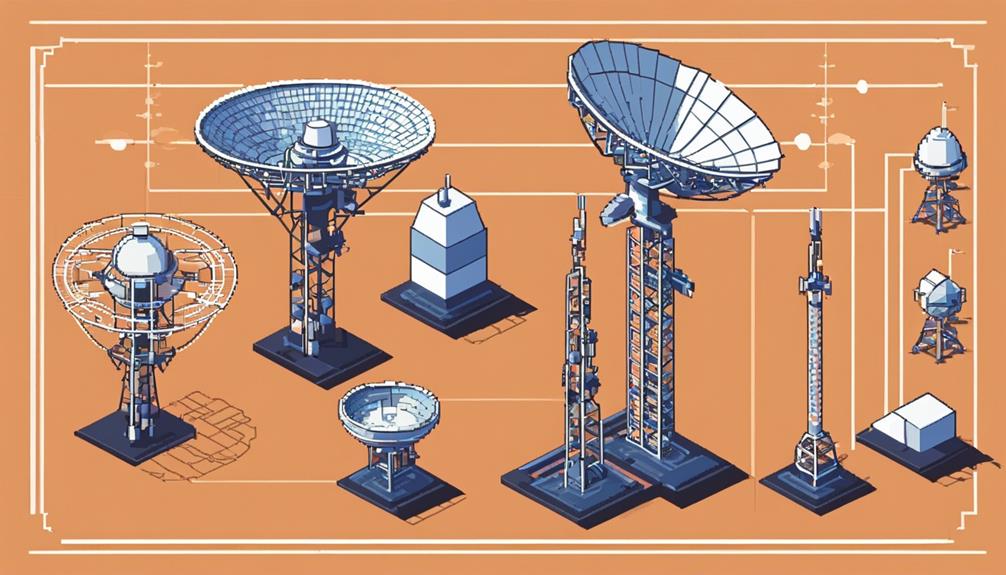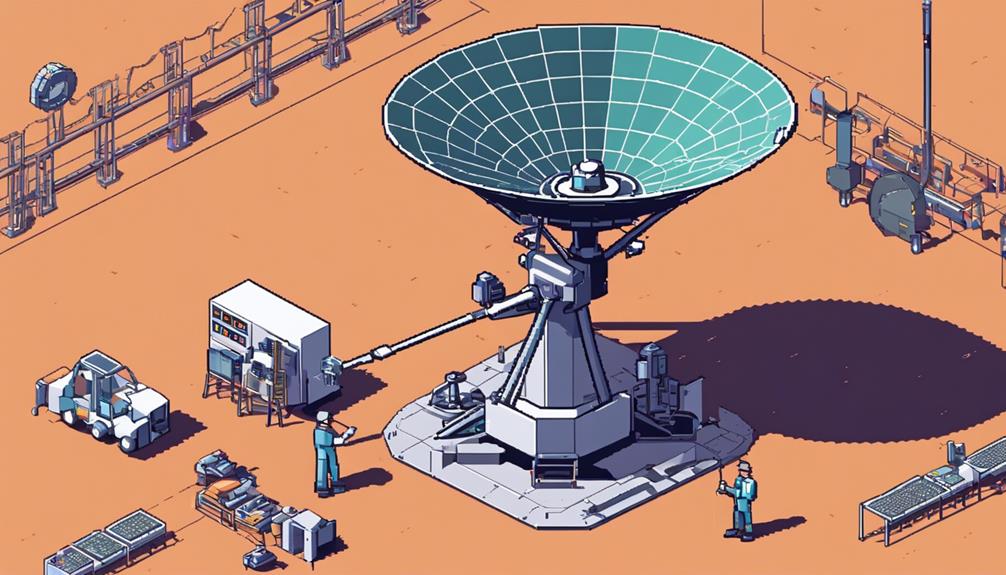Ground stations serve as vital links in space communication networks, with antenna technology being the cornerstone of their functionality. The intricate design and precision of ground station antennas determine the efficiency and reliability of data transmission from satellites to Earth. The evolution of antenna technology has revolutionized space communication, offering improved data rates and expanded capabilities. Exploring the intricacies of antenna systems in ground stations unveils a world of innovation and engineering feats that are shaping the future of space exploration.
Key Takeaways
- Dish and phased array antennas crucial for ground station communication.
- Electronically steered antennas optimize signal tracking and reliability.
- Advanced technologies enhance performance and adaptability of antennas.
- Maintenance, troubleshooting, and compatibility ensure efficient ground station operations.
Dish Antennas Overview

Dish antennas, integral components of ground station communication systems, are specialized structures designed to efficiently capture and transmit radio signals to and from satellites by utilizing their parabolic shape to focus incoming signals onto a receiver. In the realm of space communication, these antennas serve as crucial links between ground stations and satellites, facilitating the exchange of data and commands. The parabolic shape of dish antennas allows them to collect radio waves over a wide area and concentrate them onto a small receiver, enhancing the signal strength for effective communication with satellites in orbit.
Ground stations rely on dish antennas to capture weak signals from space, amplify them, and direct them towards the designated receivers. By precisely focusing radio waves onto the receiver, dish antennas optimize the reception of signals, ensuring clear and reliable communication with satellites. This targeted approach helps in mitigating interference and noise, thereby improving the overall performance of ground station communication systems.
Due to their ability to effectively capture and transmit radio signals to and from satellites, dish antennas play a pivotal role in enhancing the efficiency and reliability of space communication networks. Their design and functionality make them indispensable components in the seamless operation of ground station communication systems, enabling the exchange of vital information with satellites orbiting the Earth.
Advantages of Dish Antennas
Exhibiting exceptional directional capabilities, dish antennas provide a multitude of advantages in the realm of satellite communication systems. These advantages stem from their design and technical capabilities, making them a popular choice for ground stations. Some of the key benefits of dish antennas include:
- High Gain: Dish antennas offer high gain, which allows them to focus radio signals in a specific direction. This results in improved reception quality and signal strength, essential for long-distance communication.
- Narrow Beamwidth: The narrow beamwidth of dish antennas helps in reducing interference from other sources, ensuring a more reliable and stable communication link. This precision in signal reception is crucial for maintaining a strong connection.
- Versatile: Dish antennas are versatile in nature, capable of supporting various frequency bands. This versatility makes them suitable for a wide range of applications, from broadcasting to data communication.
- Cost-Effective: In addition to their technical advantages, dish antennas are also cost-effective solutions for satellite communication. Their efficiency in signal reception and transmission makes them a reliable and economical choice for ground stations.
- Widespread Usage: Due to their efficiency and reliability, dish antennas are commonly used in satellite ground stations for ensuring seamless data transmission. Their proven track record in the field makes them a preferred option for many communication systems.
Phased Array Antennas Introduction

Utilizing multiple radiating elements to electronically steer the beam, phased array antennas represent a cutting-edge advancement in antenna technology for communication systems. Unlike traditional antennas that rely on mechanical movement to adjust the beam direction, phased array antennas can rapidly scan the beam electronically. This feature allows for quick and precise beam steering, making them ideal for applications where agility and speed are crucial.
In communication systems, phased array antennas offer high reliability and efficiency. By dynamically adjusting the beam direction and shape, these antennas can optimize signal reception, leading to improved communication quality. This capability is particularly valuable in scenarios where maintaining a stable and strong connection is essential.
Moreover, phased array antennas find extensive use in radar systems due to their ability to scan the beam quickly and accurately. Radar systems benefit greatly from the rapid beam steering capabilities of phased array antennas, enabling them to track targets efficiently and respond promptly to changing situations. Additionally, these antennas are commonly employed in satellite communication and wireless networks, showcasing their versatility and effectiveness across different communication applications.
Benefits of Phased Array Antennas
Phased array antennas stand out in modern communication systems for their unparalleled electronic beam steering capabilities, offering rapid and precise signal direction adjustments. These antennas have numerous benefits that contribute to improved communication efficiency and interference mitigation in ground stations:
- Electronic Beam Steering: Phased array antennas can adjust the direction of the signal electronically without the need for mechanical movement, enabling swift and accurate changes in signal direction.
- Enhanced Communication Efficiency: By providing increased flexibility in simultaneously tracking multiple satellites, phased array antennas enhance communication efficiency in ground stations, leading to better data transmission and reception.
- Dynamic Beam Shaping: Through electronic phase adjustments across antenna elements, phased arrays can dynamically shape and steer beams to optimize reception, ensuring high-quality communication links.
- Reliability: Phased array antennas boast a solid-state design, resulting in higher reliability compared to traditional antennas with moving parts. This design reduces maintenance requirements and operational downtime, making them a dependable choice for ground station applications.
- Interference Mitigation: The ability of phased array antennas to mitigate interference and jamming is crucial for ensuring secure and resilient communication in ground station operations, making them an ideal choice for critical communication needs.
Phased Array Vs. Dish Antennas

Comparing the operational characteristics of phased array antennas and dish antennas reveals distinct advantages and capabilities in their respective applications. Phased array antennas employ multiple small antennas to electronically steer beams, allowing for rapid beam steering capabilities. This feature makes them highly agile and efficient in tracking multiple satellites simultaneously, a task that dish antennas struggle with due to their single beam focusing nature.
On the other hand, dish antennas, also known as parabolic antennas, use a single large dish to reflect and concentrate signals towards a receiver. These antennas are traditionally favored for high-gain applications such as deep space communication where precise focusing is essential for successful long-distance communication.
Phased array antennas excel in scenarios requiring swift beam scanning and adaptive beamforming, commonly found in radar and satellite communication systems. Their ability to dynamically adjust beam direction and shape on-the-fly gives them an edge in dynamic environments where targets may be moving rapidly.
In contrast, dish antennas are preferred for their focusing capabilities, making them suitable for applications where high-gain and concentrated signal transmission or reception are critical. This characteristic makes them ideal for long-range communication where signal strength and clarity are paramount.
Electronically Steered Antennas Insights
Employing advanced phased array technology, electronically steered antennas revolutionize beam direction adjustment in ground station communication systems. These antennas utilize electronic means to steer the beam direction without the need for physical movement, offering significant advantages in signal tracking and interference reduction. Here are some key insights into electronically steered antennas:
- Phased Array Technology: Electronically steered antennas leverage phased array technology to control the direction of the beam electronically, enabling swift adjustments for optimal signal reception.
- Beamforming Capability: These antennas provide flexible beamforming capabilities, allowing for dynamic optimization of signal strength and coverage based on specific communication requirements.
- Improved Signal Tracking: Electronically steered antennas excel in signal tracking, ensuring reliable communication links even in scenarios involving fast-moving satellites or dynamic communication channels.
- Reduced Interference: By rapidly scanning beams and dynamically adjusting signal parameters, these antennas minimize interference from external sources, leading to enhanced signal quality.
- Enhanced Satellite Communication: Advancements in electronically steered antennas have significantly improved satellite communication systems by boosting data rates and enhancing the reliability of communication links.
Electronically steered antennas play a crucial role in modern communication systems, offering agility and performance benefits that make them ideal for a wide range of applications requiring precise beam control and signal optimization.
Applications of Electronically Steered Antennas

Electronically steered antennas find critical applications in tracking moving satellites, thanks to their ability to rapidly adjust beam direction. Moreover, these antennas enhance signal reliability by mitigating interference and improving link quality. Their rapid beam reconfiguration capability enables seamless transitions between different communication targets, making them ideal for dynamic satellite tracking and mobile communication systems.
Tracking Moving Satellites
Utilizing advanced phased array technology, ground stations track moving satellites by dynamically adjusting beam direction electronically. This process allows for precise and rapid beam scanning to keep up with fast-moving satellites in low Earth orbits. Electronically steered antennas, a key component of this tracking system, offer flexibility in beamforming and the ability to track multiple satellites simultaneously. By eliminating the need for physically moving parts, these antennas enable quick and accurate tracking, ensuring seamless communication and data transmission with satellites. This technology plays a vital role in the efficiency and reliability of ground station operations, making it an essential tool in the satellite communication ecosystem.
Enhancing Signal Reliability
In the realm of signal reliability enhancement, electronically steered antennas play a crucial role through their adeptness at dynamically adjusting antenna beam direction using phased array technology. These antennas, integral to ground station antenna systems, offer unparalleled flexibility in signal reception and transmission. By utilizing phased array technology, electronically steered antennas can swiftly adapt to varying signal conditions, ensuring maximum signal reliability and data throughput. Compared to traditional mechanically steered antennas, they provide rapid beam steering capabilities, enabling quick tracking of moving satellites or signals. The applications of electronically steered antennas span across satellite communication, radar systems, and wireless networks, where their dynamic beam adjustment capabilities significantly enhance performance and efficiency in signal transmission and reception.
Rapid Beam Reconfiguration
How does rapid beam reconfiguration revolutionize the functionality of ground station antennas equipped with electronically steered technology? Rapid beam reconfiguration enables electronically steered antennas to swiftly adjust beam direction without physical movement, enhancing operational efficiency. Key points to consider include:
- Efficient Beam Steering: Utilizing phase shifters and digital processing for quick adjustments.
- Multi-Satellite Tracking: Capable of tracking multiple satellites simultaneously for optimized communication.
- Interference Reduction: Adapting beams to minimize interference and maintain signal clarity.
- Adaptability: Easily adjusting to changing communication requirements in ground station operations.
- Agile Beamforming: Providing agile beamforming capabilities to meet dynamic communication needs effectively.
Future Trends in Antenna Technology

Antenna technology is rapidly evolving, with future trends focusing on the development of phased array antennas and advanced materials like metamaterials to enhance performance and enable dynamic reconfiguration. Phased array antennas offer significant advantages in beamforming and electronic steering capabilities. By controlling the phase of signals across multiple elements, these antennas can dynamically adjust the direction of the beam without physically moving the antenna.
Metamaterials are another area of exploration in antenna design. These engineered materials exhibit properties not found in nature, allowing for the creation of antennas with improved performance and reduced size. By manipulating the structure of metamaterials at a sub-wavelength scale, antenna engineers can achieve properties like negative refractive index or enhanced electromagnetic coupling, leading to more efficient and compact antenna designs.
Moreover, the increasing use of software-defined antennas is enabling dynamic reconfiguration and optimization of antenna parameters. By leveraging software control, these antennas can adapt to changing communication needs, frequencies, and environmental conditions in real-time. This capability enhances flexibility and efficiency in communication systems.
Furthermore, the integration of artificial intelligence and machine learning algorithms in antenna systems is enabling autonomous adaptation to evolving communication environments. These technologies empower antennas to learn from data, predict optimal configurations, and optimize performance, leading to more reliable and responsive communication links in diverse scenarios. The future of antenna technology is geared towards improving efficiency, bandwidth capabilities, and interference mitigation to meet the demands of modern communication systems.
Ground Station Antenna Integration
Ground station antenna integration encompasses critical aspects such as antenna positioning techniques, signal interference mitigation, and ground station compatibility. Precise antenna placement is essential to optimize signal reception and transmission efficiency. Mitigating signal interference ensures uninterrupted communication between ground stations and spacecraft, highlighting the importance of seamless integration processes.
Antenna Positioning Techniques
Utilizing precise alignment techniques is crucial in ground station operations to ensure optimal signal reception for tracking celestial objects. Ground station antenna integration involves sophisticated systems that enable precise tracking through azimuth and elevation adjustments. Advanced tracking algorithms play a key role in compensating for the Earth's rotation, ensuring continuous communication with satellites. Additionally, antenna polarization adjustments are critical for maximizing signal strength and minimizing interference from other sources. Ground station antennas are equipped with advanced software that automates the tracking process and maintains signal lock during satellite passes.
- Precise alignment techniques
- Azimuth and elevation adjustments
- Advanced tracking algorithms
- Antenna polarization adjustments
- Sophisticated software for automation
Signal Interference Mitigation
In the realm of ground station operations, the integration of sophisticated signal processing techniques is paramount for effectively mitigating interference and optimizing communication performance. Ground station antenna systems leverage signal processing techniques and adaptive algorithms to combat interference. By incorporating filtering mechanisms and directional features, these systems can isolate desired signals while minimizing noise from external sources. Antenna designs also include shielding to reduce interference and adaptive algorithms for dynamic signal parameter adjustments. Frequency coordination and polarization adjustments further enhance interference mitigation strategies. The table below summarizes key aspects of signal interference mitigation in ground station antenna systems.
| Aspect | Description |
|---|---|
| Signal Processing Techniques | Utilized to mitigate interference and optimize communication performance in ground station operations. |
| Interference Mitigation | Techniques like filtering mechanisms, shielding, and adaptive algorithms are employed for this purpose. |
| Adaptive Algorithms | Dynamically adjust signal parameters to combat interference and enhance communication performance. |
Ground Station Compatibility
An essential aspect to consider in the seamless integration of ground station antenna systems like INTREPID is their compatibility with a wide range of frequency bands, ensuring efficient communication with satellites and spacecraft. Ground station antennas must be compatible with various bands such as L, C, S, Ku, K, and Ka for optimal performance. These systems are specifically designed to support satellite communication and spacecraft operations, offering precise tracking capabilities. Integration of third-party components is facilitated, enhancing the versatility and cost-effectiveness of INTREPID systems for space missions. Developer documentation is available to assist in the easy integration of ground station antennas into existing mission control software, streamlining the setup process and ensuring reliable communication channels.
Antenna Performance Optimization
Efficient optimization of antenna performance in ground stations is essential for maximizing signal reception and transmission capabilities. Antenna performance optimization involves a range of techniques and practices aimed at enhancing the efficiency and effectiveness of ground station antennas. Two key methods for achieving this optimization are beamforming and polarization adjustment. Beamforming allows for the focusing of the antenna's radiation pattern in a specific direction, thereby improving signal strength and reducing interference from unwanted sources. On the other hand, polarization adjustment helps align the antenna's polarization with that of the incoming signal, enhancing signal reception quality.
The following table outlines some essential aspects of antenna performance optimization in ground stations:
| Aspect | Description |
|---|---|
| Beamforming | Technique to focus antenna radiation pattern for improved signal reception. |
| Polarization Adjustment | Aligning antenna polarization with incoming signals for better reception. |
| Alignment Calibration | Ensuring antenna orientation is correct for optimal performance. |
| Maintenance | Regular upkeep and checks to preserve antenna functionality. |
| Signal Processing | Use of algorithms to enhance data throughput and minimize interference. |
Maintenance and Troubleshooting Tips

To ensure optimal functionality and performance of ground station antennas, meticulous attention to maintenance and troubleshooting procedures is imperative. Regular maintenance of ground station antennas is crucial for their longevity and performance. This involves checking for physical damages, signs of corrosion, and ensuring proper alignment to prevent signal degradation. Troubleshooting antenna issues often requires a detailed inspection of cables, connectors, and the feed horn to identify and rectify any faults that may be affecting signal reception. Calibration of tracking systems is another critical aspect of maintenance as it ensures accurate spacecraft tracking and communication. Ground station operators should routinely monitor signal strength and quality to promptly address any emerging issues that could impact data transmission. Keeping a comprehensive log of maintenance activities and troubleshooting steps is beneficial for tracking the antenna's health status, diagnosing recurring problems, and enhancing overall performance. By adhering to these maintenance and troubleshooting best practices, ground station operators can maximize the efficiency and reliability of their antenna systems.
- Regular maintenance includes checking for physical damages, corrosion, and misalignment.
- Troubleshooting involves inspecting cables, connectors, and the feed horn for faults.
- Calibration of tracking systems is essential for accurate spacecraft tracking.
- Monitoring signal strength and quality helps identify potential issues.
- Maintaining a log of activities aids in diagnosing problems and improving performance.
Frequently Asked Questions
What Is the Antenna in the Earth Station Technology?
In Earth station technology, an antenna serves as a vital element for receiving and transmitting signals between space objects and Earth. It plays a critical role in amplifying incoming radio waves and efficiently collecting data for space communication. By amplifying and reflecting radio waves, the antenna converts them into electrical signals for further processing. This conversion process is essential for the reception, conversion, and transmission of signals in the realm of effective space communication.
How Do Ground Stations Communicate With Satellites?
Ground stations communicate with satellites by utilizing sophisticated satellite tracking systems that ensure a continuous line of sight connection. Signal reception involves capturing radio signals through antennas, followed by frequency modulation for data transmission. Communication protocols are employed to establish efficient data exchange. Signal processing techniques, such as demodulation, are then used to extract the original source signal. Beamforming technology is utilized to optimize signal strength and quality during this communication process.
How Big Are the Antennas on AWS Ground Station?
Like towering sentinels in the realm of satellite communication, the antennas on AWS Ground Station stand confidently at sizes ranging from 2.4 to 4.0 meters. These structures, comparable to the wingspan of a majestic eagle, harness cutting-edge technology to amplify signal strength with precision. Their robust design not only ensures stable links but also reflects advancements in cost-efficient solutions for temporary setups in dynamic environments.
What Are the Components of a Ground Station?
Ground station equipment encompasses various components crucial for satellite communication. Tracking systems ensure precise alignment with satellites, while signal processing extracts and decodes incoming data. The data is then transmitted through these stations for further analysis. Each component, from antennas to receivers, plays a pivotal role in ensuring seamless communication between satellites and ground stations. This intricate system forms the backbone of satellite communication networks, enabling data exchange and transmission across vast distances.

